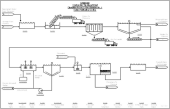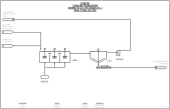
 |
 |
||
| Click to view schematic display A | Click to view schematic display B | ||
Process Description
Simtronics Wastewater Treatment Plant simulator replicates a typical process for treating raw municipal sewage so it can be safely discharged to the environment.
Raw sewage from the municipal collection system flows to the inlet holding tank which provides surge capacity. Coarse screens then remove debris and large objects from the sewage that flows into the process from the holding tank. After debris removal, the sewage flows into the grit chambers. The grit chambers employ engineered baffles and weirs designed to reduce the velocity of suspended inorganic solids so they separate and fall to the bottom of the grit chambers. Lighter density organic solids will tend to stay suspended in the liquid phase so they will be carried out with the water exiting the grit chambers. The grit chambers have mechanical scrapers to remove the grit from the bottom of the grit chambers. This grit is sent off-site for disposal.
The overflow liquid from the grit chambers flows to the large settling basin where the suspended lighter density sludge is allowed to separate from the liquid. Also, any water insoluble compounds such as grease and oils will float on the top of the liquid surface. At one end of the basin, the floating phase will be skimmed off and flows to the aerobic digester. The raw sludge is collected at the base of the settling tank and is sent to the aerobic digester.
The aerobic digesters use special bacteria and oxygen from injected air to convert potentially hazardous organic compounds as well as disease-carrying microorganisms in the raw sludge to environmentally benign compounds. The digesters consist of three stages to ensure nearly complete conversion of the organics and microorganisms in the raw sludge. Digested sludge is taken off to the gravity thickener for bulk water removal prior to transporting the digested sludge for disposal.
The untreated sewage water from the settling tank flows on to the activated sludge system for conversion of the remaining soluble organic compounds and organisms in the water to activated sludge and environmentally benign compounds. The activated sludge system consists of the aeration tank, clarifier and activated sludge pumps. Produced activated sludge, which is biologically active, is recirculated to the aeration tanks. In the presence of oxygen, the biological components of the activated sludge will use the organic compounds in the entering water as nutrients to grow more activated sludge. The activated sludge system is, therefore, self-propagating.
The agitated mixture of water and activated sludge from the aeration tanks flows to the clarifier which allow the activated sludge and the water to separate. The water is taken off to the flocculant mixer while activated sludge is recirculated to the aeration tanks by the activated sludge pumps. Excess activated sludge accumulates over time and is intermittently taken off to disposal via a line from the discharge of the activated sludge pumps. The rate of activated sludge produced will depend on the concentration and flow of nutrients in the water from the settling tanks.
Water from the activated sludge clarifier is finely mixed with flocculant in the flocculant mixer to help precipitate any remaining suspended solids out of the water. The mixture then flows on to the secondary settler to allow separation of any solids prior to filtering the water. The water flows to the tertiary filters which consist of beds of sand, gravel and coal. The filtered water is collected in the effluent storage tank which provides reserve capacity prior to disposal of the water to the environment.